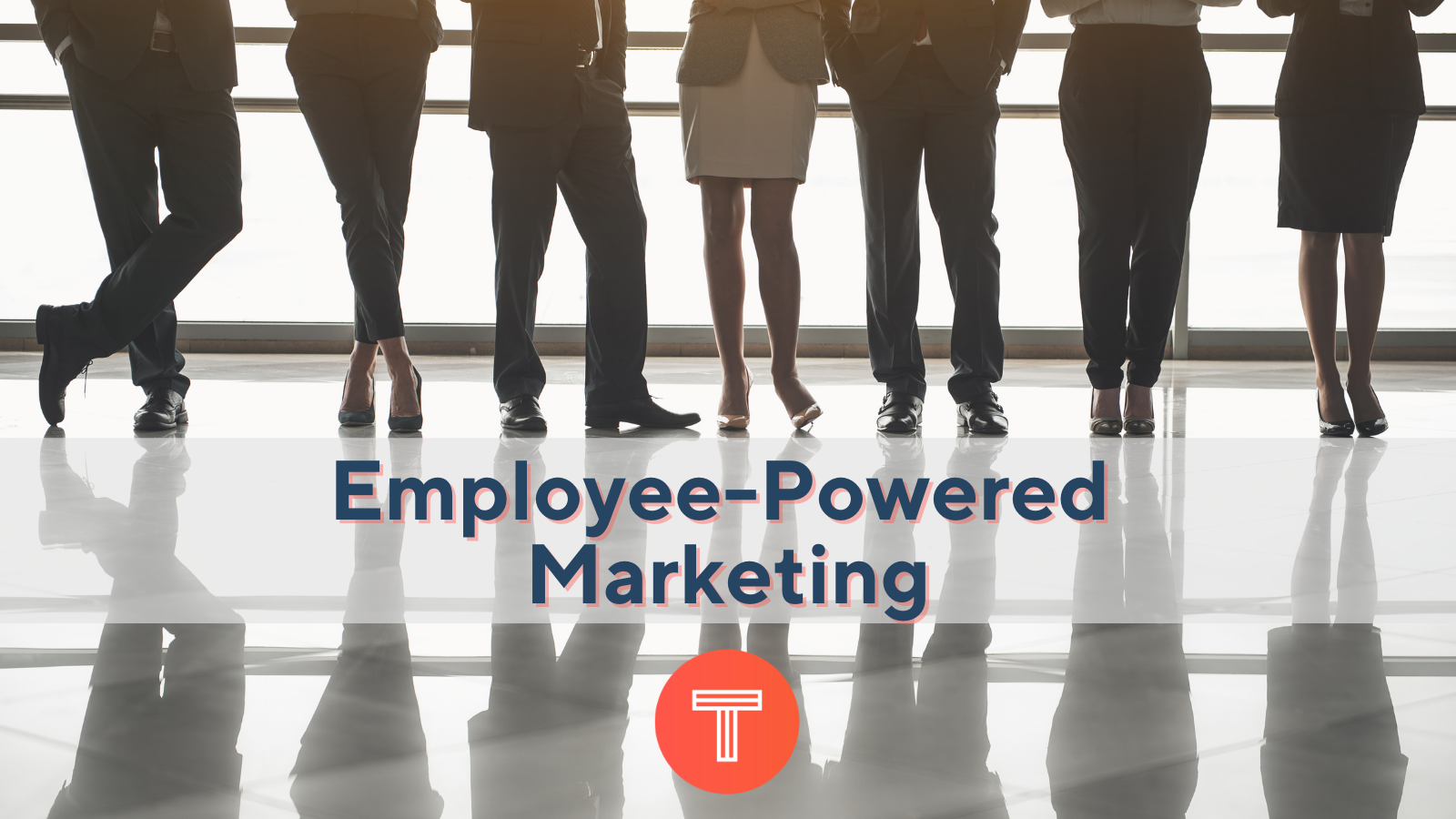Employee-powered marketing democratizes the content creation process and turns every member of staff into an internal influencer. There are a variety of names: employee advocacy social program, employee-powered marketing, employee-driven communications, but all of them fall under the umbrella of Employee-Generated Content (EGC)
EGC and employee-powered marketing are new territories for many marketing and communications professionals. Let’s dig into some frequently asked questions about the strategy.
What is Employee-Powered Marketing?
Employee-Powered Marketing is a strategy where every member of a company’s staff is empowered to create, distribute, and contribute to marketing efforts.
Marketing and communication teams are exponentially outnumbered in most businesses. This strategy embraces that and encourages all employees to create content and share branded messaging. This content is formally known as employee-generated content.
Democratizing marketing in this way can have amazing results. Our research shows that messaging is reshared 24 times more when distributed by employees instead of brand accounts. Furthermore, that content also experiences 8 times the engagement of brand-shared content.
Additional research has found that 33% of employees are already posting messages, pictures, or videos about their employer without any encouragement from their company. The implementation of an employee advocacy program focuses that energy and increases participation to 50%.
How do I start an employee advocacy program?
A well-implemented employee advocacy program starts with the “WHY”. Spend time thinking about specific goals that you’re hoping to achieve with this program. The three main types of employee advocacy goals focus on Human Resources and Recruitment, Marketing and Communications, or Sales Acceleration.
Next, leadership buy-in at all levels of the organization can make or break these programs. Company leaders should not just buy-in, but actively participate to model the behavior.
Finally, show results and help employees understand how they contribute to organizational goals. People want to know that they’re helping. Showcasing content, celebrating contributors, and sharing data are fantastic ways to keep people interested in the program.
For a step-by-step guide, visit our blog on launching an Employee Advocacy Program powered by Social Media.
Who “owns” the employee advocacy program, Marketing or Human Resources?
Simply put, both. An employee-powered marketing program is best activated as a collaboration between departments. Marketing and Communications departments will have a clear understanding of the type of content a campaign should produce, the channels it should be distributed on, and likely the microsites or hashtags that will support the effort. Human Resources often has a clearer understanding of the culture of an organization, what would incentivize participation, and the implementation of policies support an overall culture of employee-driven marketing.
The best practice is always to start with marketing and human resources. As the program grows and the goals diversify, additional departments should be brought into the fold. A sales leader can suggest what content drives sales acceleration. A diversity and inclusion specialist can recommend strategies to support recruiting efforts.
Regardless, start the planning committee small. Many employee advocacy programs have died in committee. Start small, grow organically, then sensibly add people to the project’s steering team. We talk more about this in the Employee Advocacy webinar.
How you do keep employees motivated to create content?
Motivation comes from a variety of fronts. Based on experience, there are four main drivers of participation and motivation: leadership, culture, incentive, and regulation.
Leadership
Look to leaders to drive participation. Meaningful participation by managers of all levels is a great place to start. You should also look beyond official leadership. Find people of influence within departments or teams. This could be the person with the longest tenure in their role, known by the team as the local expert. It could be the new staff member who is excited to contribute and shares that infectious enthusiasm.
Find someone to be your champion in every department and on every team. Show your appreciation for them and give them the tools to rally their co-workers.
Culture
A strong, connected culture makes everything easier. You’re asking employees to open up and share their perspectives on the company. They will not do this if it runs counter to your culture. The best employee-generated content is created organically. It often showcases normal experiences like coworkers sharing lunch, celebrating holidays, and participating in -often mundane- daily activities. Some corporate cultures are more conducive to the practice and require less effort to start. Other cultures, particularly those who are more siloed due to department or geography, may require the establishment of new cultural norms before employees are ready to share.
Incentive
Before discussing specifics, we should break down the difference between incentivization and gamification. Both are possible, reward-driven ways, to drive the staff side of employee-powered marketing. Bravon has a simple breakdown:
Incentives
Incentives are transactional. They motivate employees to perform a specific action in exchange for a payout. For example; if you share one piece of content, you’ll get one widget as a reward.
Gamification
Gamification is a continuous process built on a series of challenges. It seems to drive internal (intrinsic) motivation. Rather than driving motivation to reach a specific outcome (the prize), it focuses on the activity or series of activities that an employee (gamer) must take to achieve that outcome.
Incentives vs Gaming
Simply put, incentives drive the completion of a specific task. Gamification drives the adoption, and maintenance, of a specific behavior. Both are effective motivators, and a review of company culture will help guide the decision to use either, both, or neither option.
Whether using incentivization or gaming, the best practice is to make the rewards meaningful. Find items, swag, or rewards that your employees want to get. Cheap items or low-impact rewards like the “Corporate Pizza Party” can often be seen as patronizing, infantilizing, or disingenuous.
Regulation
The fastest and easiest way to start an employee-powered marketing campaign is to add an expectation for contribution to a staffer’s job description. But just because it is fast and easy doesn’t mean that it is the right way. Beware leaning too heavily on regulation. This leads to campaign fatigue and encourages a more lethargic form of participation with employees only contributing to check the box.
The best way to use “regulation” as a driver of employee motivation is to add content creation or contribution to existing processes. For example, if you have field staff that are conducting events, add a photo list to their process. Ask for specific shots like the team in action, the booth or set-up, and post-event team dinner. This way, the content request is less intrusive.
What are the legalities with using Employee-Generated Content? Do they need to sign a waiver, ask permission, or more?
This is often one of the earliest questions you’ll encounter from leadership as you launch an employee-powered marketing campaign. There are several different perspectives on this, but the main thing to keep in mind is Respect. You should always respect your contributors, ask permission, and use online content mindfully.
We have a primer on Understanding UGC User Rights.
Content Ownership – Creative Roles
Content ownership should be the most straightforward part of the conversation. Typically, copyright law says that once a piece of intellectual property is put into a permanent form it is owned by the creator. This could be written words like a tweet or status update. This could be rich media like an Instagram post or TikTok. When your employees create content, they generally own it.
Things can get tricky when content is created “on the clock”. Some professions, like designers and copywriters, may find that their work is owned in-part or entirely by the company. Things that are created as part of a job function generally are owned, and/or licensed, by the company paying that person’s salary.
That said, it is still a matter of respect and decorum to let the person know if you’re using their content. It also doesn’t automatically extend to all their social channels and other media pieces. As mentioned above, the worst way to obtain content is through regulation. Ask for permission, even if it is not necessarily a legal requirement.
Content Ownership – Everyone else
The company may have an interest in the intellectual property of creatives in its employ. What about employee-generated content from someone in non-creative roles like accounting or sales?
They should be approached the same way that you would ask for permission to use content from a customer or partner. Ask for permission, document acceptance, and use the content respectfully.
Opt-In Participation
Many savvy marketers are turning to an opt-in participation strategy to avoid the headache, and liabilities, of the two previously mentioned content ownership scenarios. As they design their employee-powered marketing program, they leave budget to launch a microsite. Here, employees of all stripes can share content, opt-in to terms of service, and be part of a larger conversation. This also centralizes the content collection process, making it easier for the project manager to aggregate media.
You can launch an engaging, branded microsite in minutes using TINT Experience Builder. No developer resources necessary. Give your staff a way to engage. Explore TINT Experience Builder today.
What about organizations that are worried about off-messaging posts or backlash from bad content?
Employee-Powered Marketing is built on trust and authenticity. You need to be able to trust your team to share relevant content and stay on message. If you are immediately concerned about the negatives of EGC, then perhaps there is a cultural issue that needs to be addressed before implementing an employee advocacy program.
That said, it is important to provide guidelines and guardrails. Your staff should, and this could be a big assumption, know the basic rules of your brand. Employee-powered marketing does not sacrifice brand integrity, but rather, builds it. Encourage staff to share content but emphasize that they shouldn’t necessarily be working towards a final “polished” product. They should share candid photos, interesting articles, and other elements of the business that would look sensible as an organic post on social media. There should not be an expectation for people to design content or add elements like logos and watermarks. That is still something that should be left to the marketing and communications department.
A popular guardrail is to use an employee advocacy tool to support the “signal boost” element of employee-powered marketing. Tools like Hootsuite Amplify will push relevant, and marketing-approved, content to employees. Employees may then share at their discretion. A favorite element of Amplify is the ability to populate copy, images, and hashtags, taking any guesswork out of the process. This is also useful for staff who may not be ready to completely buy-in to the process. It is an easier ask to “Click to share” rather than asking for a major lift like designing the post in its entirety.
How do we punish employees who step out of bounds?
You probably shouldn’t hire employees that you don’t trust on social.
Cultural issues aside, this is the reason why Human Resources is often an important element of the employee advocacy program design process. They should be able to advise on both the carrot and the stick.
Also, be mindful and flexible when reviewing employee content. Let’s not forget Tony Piloseno, the TikToker fired from Sherwin-Williams for creating content outside the scope of his role. His massively popular account could have been a great asset for the company. Now, he is launching his own paint line with a new paint company based out of Florida.
After reading all this, where do I begin?
TINT has been trusted by over 5,000 brands around the world. We’ve worked with top brands across industries to create innovative content programs. Schedule time with one of our employee-generated content experts and launch your employee advocacy campaign today.



